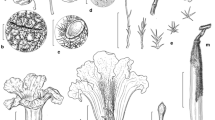Abstract
Herbarium specimens (c. 1 000) and population samples (76) have been screened for the occurrence of diploid representatives ofTaraxacum sect.Ruderalia (T. sect.Vulgaria, nom. illeg.). The area studied comprises German Democratic Republic, Poland, Czechoslovakia, Hungary and parts of Austria, Yugoslavia, and Rumania. Diploids are common from the Valley of the Moravia river on southwards. Isolated outpost localities are found in S. Poland and extend far to the north: neighbourhood of Berlin. Based on the pattern of distribution in Czechoslovakia, the Pannonian (thermophilous) phytogeographical character of the diploids is discussed. Special attention has been paid to morphological differences between di- and triploids in Czechoslovakia. The study provides a basis for further biosystematical and taxonomic studies in the relationships between diploids and polyploids as well as in the stability of agamospecies.
Similar content being viewed by others
References
Doll, R., 1982: Grundriß der Evolution der GattungTaraxacum Zinn. — Feddes Repert.93: 481–624.
Elzinga, D., Kamp, J. van de, Nijs, J. C. M. den &Sterk, A. A., 1987: Cytogeography and ecology of diploids and triploids ofTaraxacum sectionTaraxacum in South Limburg, Netherlands. — Proc. Neth. Acad. Sci., ser. C,90: 431–442.
Fürnkranz, D., 1960: Cytogenetische Untersuchungen anTaraxacum im Raume von Wien. — Österr. Bot. Z.107: 310–350.
—, 1966: Untersuchungen an Populationen desTaraxacum officinale-Komplexes im Kontaktgebiet der diploiden und polyploide Biotypen. — Österr. Bot. Z.113: 427–447.
Grant, V., 1971: Plant speciation. — New York: Columbia University Press.
Holmgren, P. K., Schofield, E. K., Keuken, W., 1981: Index herbariorum. 1. The herbaria of the world. Edn. 7. — Utrecht: Junk.
Jenniskens, M.-J. P. J., 1984: Aspects of the biosystematics ofTaraxacum sect.Taraxacum, pp. 69–151. — Amsterdam: PhD thesis.
—,Nijs, J. C. M. den, Huizing, E. A., 1984: Karyogeography ofTaraxacum sect.Taraxacum and the possible occurrence of facultative agamospermy in Bavaria (Federal Republic of Germany) and north-west Austria. — Phyton (Austria)24: 11–34.
—, —, 1985: Crossability and hybridisation of taxa ofTaraxacum sectioTaraxacum from central and western Europe. — Proc. Neth. Acad. Sci., ser. C,88: 297–338.
Kirschner, J., Štěpánek, J., 1987: Again on the sections inTaraxacum (Cichoriaceae). Studies inTaraxacum 6. — Taxon36: 608–617.
Müller, U., 1972: Zytologisch-embryologische Beobachtungen anTaraxacum-Arten aus der SektionVulgaria Dahlst. in der Schweiz. — Ber. Geobot. Inst. ETH, Stiftung Rübel41: 48–55.
Nijs, J. C. M. den, 1984: Biosystematic studies of theRumex acetosella complex (Polygonaceae) 8. A taxonomic revision. — Feddes Repert.95: 43–66.
—,Hulst, A. van der, 1982: Biosystematic studies of theRumex acetosella complex 5. Cytogeography and morphology in the Czech Socialistic Republic and a part of Lower Austria (Austria). — Folia Geobot. Phytotax.17: 49–62.
—, —, 1988: Cytogeography ofTaraxacum sectionErythrosperma: diploid sexuals in SE. and SW. Europe. — Bot. Jahrb. Syst.110: 83–93.
-Menken, S. B. J., Vlot, L., 1987: Gene flow in a di-triploid mixed stand ofTaraxacum (Asteraceae) in the Odenwald, BRD as measured by isozyme analysis. — Abstracts 14th Int. Bot. Congress, Berlin: 307.
—,Sterk, A. A., 1980: Cytogeographical studies ofTaraxacum sect.Taraxacum (= sect.Vulgaria) in Central Europe. — Bot. Jahrb. Syst.101: 527–554.
—, —, 1984a: Cytogeography ofTaraxacum sectionTaraxacum and sectioAlpestria in France and some adjacent parts of Italy and Switzerland, including some taxonomic remarks. — Acta Bot. Neerl.33: 1–24.
—, —, 1984b: Cytogeography and cytotaxonomy of someTaraxacum sections in Belgium and Northern France. — Acta Bot. Neerl.33: 431–455.
Quitt E., 1971: Klimatische Gebiete der Tschechoslowakei. — Studia Geographica16: 1–73, map.
Richards, A. J., 1970a: Hybridization inTaraxacum. — New Phytol.69: 1103–1121.
—, 1970b: Observations onTaraxacum sect.Erythrosperma Dt. em.Lindb. fil. in Slovakia. — Acta Fac. Rerum Nat. Univ. Comenianae Bot.18: 81–120.
—, 1985: Sectional nomenclature inTaraxacum (Asteraceae). — Taxon34: 633–644.
—, 1986: Plant breeding systems. — London: Allen & Unwin.
Roetman, E., Nys, J. E. M. den, Sterk, A. A., 1988: Distribution and habitat range of diploid, sexual dandelions (Taraxacum sectionVulgaria), a Central European flora element in The Netherlands. — Acta Bot. Neerl.37: 81–94.
Sahlin, C. I., 1972: ZurTaraxacum-Flora Süddeutschlands und Österreich. — Memoranda Soc. Fauna Flora Fennica48: 75–84.
—, 1979: Einige neueTaraxacum-Arten aus Bayern. — Ber. Bayer. Bot. Ges.50: 173–187.
Slavik, B., 1984: Grundlegende Phytochorotypen der Tschechischen Sozialistischen Republik. — Preslia56: 241–265.
Soest, J. L. van., 1966: NewTaraxacum species from Europe 1 – 4. — Proc. Neth. Acad. Sci., ser. C,69: 432–489.
Štěpánek, J., 1982: Die Chromosomenzahlen von tschechoslowakischen Arten der GattungKnautia L. (Dipsacaceae). — Folia Geobot. Phytotax.17: 359–386.
—, 1985:Knautia L. Chrastavec. — InBertová, L., (Ed.): Flóra Slovenska4: 154–177. — Bratislava: VEDA, vydavatelstvo Slovenskij akadémie vied.
Sterk, A. A., 1987: Aspects of the population biology of sexual dandelions in the Netherlands. — InHuiskens & al. (Eds.): Vegetation between land and sea: structure and processes, pp. 284–290. — Den Haag: Junk.
—,Hommels, C., Jenniskens, M.-J. P. J., Neuteboom, J. H., Nijs, J. C. M. den, Oosterveld, P., Segal, S., 1987: Paardebloemen: planten zonder vader. Variatie, evolutie en toepassingen van het geslacht Paardebloem (Taraxacum). — Utrecht: KNNV.
Tschermak-Woess, E., 1949: DiploidesTaraxacum vulgare in Wien und Niederösterreich. — Österr. Bot. Z.96: 56–63.
Vlot, L., 1986: Patroonanalyse van en genetische variatie binnen een 2x–3x gemengde populatie vanTaraxacum sectieVulgaria in het Odenwald (B.R.D.). Doktoraalverslag. — Amsterdam: University of Amsterdam.
Author information
Authors and Affiliations
Rights and permissions
About this article
Cite this article
den Nijs, J.C.M., Kirschner, J., Štěpánek, J. et al. Distribution of diploid sexual plants ofTaraxacum sect.Ruderalia in east-Central Europe, with special reference to Czechoslovakia. Pl Syst Evol 170, 71–84 (1990). https://doi.org/10.1007/BF00937850
Received:
Issue Date:
DOI: https://doi.org/10.1007/BF00937850




